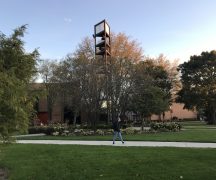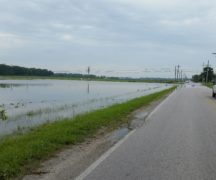By DAVID DUPONT
BG Independent News
Viewers aren’t shy about letting WTOL meteorologist Chris Vickers know what’s on their minds. Their comments can be particularly forthright when it comes to weather and climate change.
On a particularly cold day in January, he’ll get an e-mail declaring: “Global warming is a scam.”
It’s not only the climate change skeptics who speak out. Any time there’s flooding, he’ll hear from someone pointing the finger at global warming.
In neither case can these local weather events prove or disprove whether global warming is happening.
Vickers served as the guest speaker for the first day of Earth Week at Bowling Green State University Monday
Those comments say more, he said, about people’s way of thinking about the world. He sees two tendencies.
People suffer from cognitive dissonance that causes them to seek out information that confirms their beliefs in order to avoid “the discomfort of contradictory beliefs.” And he sees confirmation bias where any new information is interpreted as supporting their existing beliefs.
In his talk, Vickers delved into the science and numbers behind climate change, both globally and locally.
First, Vickers drew a distinction between global warming and climate change. “Global warming,” he said, “describes the observed and projected increase in global temperatures over time.”
The global climate is “a dynamic system.”
Many factors, including solar radiation, volcanic eruptions, and the tilt of the earth have an impact on climate.
The presence of greenhouse gases — carbon dioxide, methane, and water vapor — also plays a role. The greenhouse effect is a naturally occurring phenomenon that traps some heat in earth’s atmosphere. Without it, temperatures would be 20-30 degrees lower.
Climate change, he said, “includes the warming and the side effects that are resulting from that warming.”
Those side effects include melting glaciers, heavier rainstorms, more frequent droughts, and prolonged heat waves.
Vickers noted that 2015 through 2018 were the warmest years on record. The temperature in that period was anywhere from .8 to 1 degree Celsius above average. The heating was most profoundly felt in the Arctic. The sea ice is now 230,000 square kilometers under the previous low point.
Carbon dioxide is increasing in the atmosphere. That’s a clear indication that it’s contributing to rising temperatures, he said.
Science cannot pinpoint the degree to which human activity is contributing to the rise in temperatures.
“What science does know is we are having a direct impact on our environment, and how we are changing our climate systems,” he said.
The United Nations’Intergovernmental Panel on Climate Change has determined there’s greater than a 95-percent chance that human activity accounts for more than half the increase in global temperatures.
Temperatures have fluctuated at other times in the earth’s history, Vickers noted. What is notable now, he said, is how quickly it’s happening. “The rate or acceleration is what’s most concerning to us as scientists.”
Vickers turned his attention locally where increased temperatures are being felt. Last summer started cool but then it heated up to 2.5 degrees above average.
“This is the data that really caught me,” Vickers said. “We had 31 days of 90 degrees or warmer” from May through September. That’s more than twice the average. And overnight temperatures did not dissipate as much, so here was little relief from that oppressive heat.
That’s of particular concern in cities, he said. The top weather-related “killer” is heat. It claims the lives of the old and the very young as well as people with asthma and other breathing problems.
In the past 50 years, summers have become increasingly warm, to the tune of 3 degrees Fahrenheit warmer.
Also, Vickers pointed to September, 2017, when there were six consecutive days of 90 or higher, four of them set records, the other two came very close.
That, coupled with sparse rainfall, caused an algae bloom in Lake Erie. The river turned green. “If that’s not a visible sign that something unusual is happening, I don’t know what is.”
While the level of precipitation has been stable, there’s a higher frequency of complexes of thunderstorms that “explode over specific areas causing floods and flash flooding.”
Winters are both warmer — 4.6 degree Fahrenheit — and wetter “by a pretty good margin,” he said.
Still when looking at local attitudes as measured by the Yale Climate Opinion project, people in Wood County are somewhat less willing compared to the national average to believe that: global warming is happening, 68 percent; it’s caused mostly by human activities, 54 percent; and global warming is affecting weather, 60 percent. All those a 2-3 percent below the national average.
When considering the 5th Congressional District, the numbers are even lower, according to the project’s website.
The goal is to try to get to zero net emissions, Vickers said. That means switching to alternative fuel and green sources of power.
That is what the Paris Climate Accords call for, though President Trump is threatening to withdraw from the accords, joining Nicaragua and Syria as the only countries not signing on.
Reducing our carbon footprint to zero in the next two decades, Vickers said, is “something we need to do that as a society, not just on an individual basis.”
It’s a matter of “reducing greenhouse gas emissions today to avert disaster in the future.”





